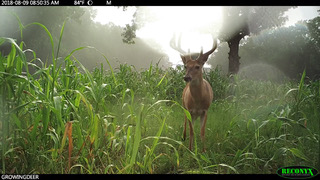Don’t Lose Your Food Plots to Drought: How to Create Drought Resistant Food Plots
Filed under: Food Plots, Hunting Blog
A common problem with food plots (any crops) is a lack of soil moisture. All forage crops need adequate soil moisture to produce lots of quality forage. Without moisture plants can’t grow or transfer nutrients. To compound this problem, food plots are often located in areas that don’t have great soils and therefore they don’t hold moisture.
Even if a decent amount of rain occurs, soil moisture can be rapidly lost if the soil is bare. A primary factor of how much moisture is lost is the soil’s surface temperature. Following are some results from recent research about soil moisture loss.
• At 70 degrees soil temperature, 100 percent of the soil moisture is used for plant growth.
• From 95 to 113 degrees, 15 percent of soil moisture is used for plant growth and 85 percent lost through evapotranspiration.
• At 130 degrees, 100 percent of soil moisture is lost through evapotranspiration.
It’s impractical to irrigate most food plots. However, it’s fairly easy to conserve soil moisture. In fact, many farmers in the north central plains are now producing huge yields of corn and soybeans without the expense of irrigating! They do it by simply using shade and wind protection to reduce soil moisture evapotranspiration. These farmers simply ensure that at all times there’s a living crop covering the soil and/or a thick layer of mulch created from the remains of past crops.
They do this by planting blends of cover crops that produce a lot of tonnage sometime during their annual crop rotation. The standing crop shades and usually conserves more soil moisture than it uses. They then plant their cash crop using the previous cover crop remains (biomass/mulch) to take advantage of the soil moisture!
I’ve been using this system to conserve soil moisture in the rocky, drought-prone soils of the Ozark Mountains. This system is actually easier in food plots because deer are used to harvest the crop. Unlike a combine used to harvest a farmer’s crops, deer don’t care if there’s a blend or plants of differing heights.
We experienced a wicked drought at The Proving Grounds this summer. During July we planted an experimental blend developed in partnership with Eagle Seeds. The design of this blend was to provide some quality forage for deer and improve the soil by adding tons of biomass that will be converted to mulch and then high-quality soil. The blend was also designed to shade the soil and conserve the very limited soil moisture.
The experiment was literally a huge success. It provided way more quality browse than a normal drought-stricken plot could and provided tons of biomass. We are now using a Genesis drill to plant Eagle Seeds Fall Buffalo Blend directly into the terminated summer crop.

It’s raining now but the forecast calls for the temperatures to return to the 90s with limited chances of rain. The ground cover from the terminated, experimental summer blend (which included seven different crop varieties) will do an excellent job of conserving soil moisture, shading the soil, and providing almost 100% erosion and weed control. This is a very easy win-win-win!
In addition, the decomposing vegetation from the experimental summer blend (which I call the Buffalo Summer Soil Builder Blend) will be very high-quality fertilizer for the fall crop.
Another advantage is the terminated crop is excellent food for earthworms and other beneficial soil life. Gosh – it’s easy to see why I haven’t needed to add any lime or fertilizer in five years and have greatly reduced the amount of herbicide needed!
If you’d like more information about The Buffalo System to produce better forage for less cost, check out this link to videos at GrowingDeer.com.
Enjoy Creation,
Grant



